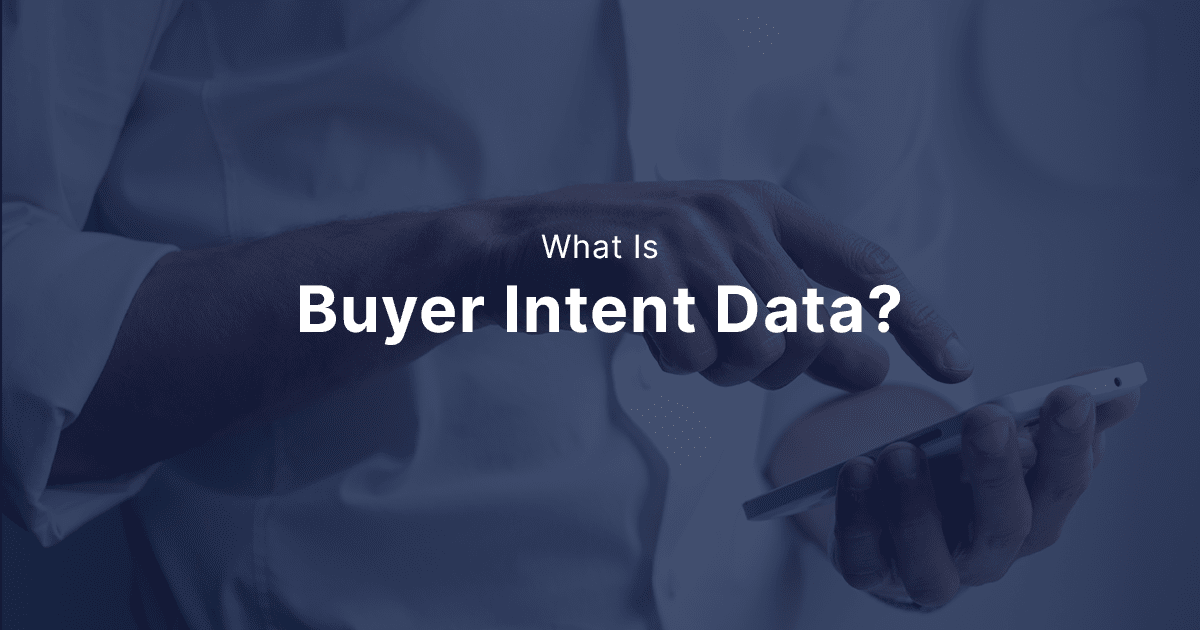Imagine being able to tailor your marketing strategy to a perfect audience at exactly the right time.
97% of consumers research products and services before making a purchasing decision. That means, your potential prospects are actively looking for a solution to a problem they have.
You’re probably thinking to yourself ‘if there was such a thing, I’d be closing hundreds of sales per month…’
Enter: intent data.
Buyer intent data gives you unparalleled insight into your prospect’s behavior through the use of intent signals. This data allows you to ‘jump the queue’ and gives you the opportunity to pitch to potential customers at exactly the right moment.
What Is Intent Data?
Intent data is information collected about a person’s behavior online. It’s formed on behavioral signals that indicate what topic, product or service a person may be interested in. Giving you an understanding of their perceived intent.
The power of buyer intent data is that it allows sales and marketing teams to prioritize certain groups of people based on their intent. Or, at least, how active that intent is.
For most companies, this data provides deeper insights into the buying process to better tailor marketing strategies to their target audience.
You can gauge the level of a buyer’s intent through the content they consume. For example:
- Reading specific articles on your website.
- Product comparison and review pages.
- Frequency of their visits and how often they return.
- Downloads (whitepapers, case studies, eBooks).
- Engagement levels (email opens, time on site, clicks)
The more data points collected, the stronger the intent signals.
In its simplest form, intent data tells you when a lead is actively researching online before making a purchase decision.
What Are the Benefits of Using Buyer Intent Data?
The first (and most important) benefit of using intent data is that you are eliminating the risk of engaging with uninterested buyers.
You’re essentially streamlining your prospecting pipeline to qualified buyers only.
Not only will that dramatically increase your conversion rate potential, but it will also give your sales and marketing team a huge advantage over your competitors.
Imagine how confident your staff will be knowing that their lead generation just became that much easier and more effective.
Supercharged Account-Based Marketing
A fundamental aspect of account-based marketing (ABM) is targeting accounts who are a good fit for your company’s products or solution.
With over 67% of brands utilizing account-based marketing, you can imagine that prospective buyers are inundated with cold and non-personalized pitches all day long.
By leveraging the power of intent data, you immediately give your sales and marketing team an unfair advantage.
You’re able to strategically prioritize and personalize your lead generation campaigns with granular insight. Meaning, you can segment your outreach lists based on the intent of their behaviors.
Remember, account-based marketing is only as successful as your personalization.
Enhanced Ad Campaigns
How many times have you been served an ad on Facebook, Google or LinkedIn that manages to reach you at exactly the right time?
Chances are you were targeted by a group of smart markets (just like the people reading this article).
Why?
Intent data gives you context. It allows you to understand which topics and interests capture people’s attention most.
You can use this knowledge to create ad campaigns and distribute content that aims to answer your prospect’s questions. Just by aligning your content with somebody’s pain points at the right time can result in an increased flow of qualified leads.
Capture Interest During the Buyer Journey
An effective B2B marketing campaign is one that’s delivered on time. By this we mean capturing people’s interest before they reach out to a salesperson themselves.
Most B2B buyers are already 57% of the way through the buying cycle by the time they reach out to a company for more information.
57%…a B2B campaign is too late by this point.
With buyer intent data, you can help trigger that lightbulb moment in your prospect’s mind. Helping them believe they’ve made the decision themselves by giving them enough information to engage with your company.
Intent data allows you to:
- Have the opportunity to speak to customers before they reach out.
- Tailor your messaging based on content consumption.
- Build relationships with leads immediately.
Produce Relevant Content at Scale
Across any marketing channel, relevancy is always key. In fact, the recipe to most successful campaigns is nearly always relevancy and timing.
We’ve already highlighted how intent data can put you in front of the right audience at the right time.
But here’s how it can help your marketing teams produce relevant content at scale.
- Build landing pages on your site that answer specific questions.
- Connect and segment pages based on topics.
- Create landing pages by industry and application.
Once you begin utilizing intent data, you can capitalize on inbound marketing and lead generation through downloads and specific on-site events that you can easily track.
How Is Buyer Intent Data Collected?
Intent data is created using billions of streaming behavior signals from thousands of B2B websites and media publishers. This intent data is then collected and aggregated each week by third party vendors.
These signals range across thousands of topics to show both trends and surges of interest in particular topics.
For example, if there is a peak in interest for B2B buyers looking for a marketing automation platform – the data will reflect that (thus indicating an increase in purchase intent).
Because a lot of this raw data ranges in the millions, it would be hard to manually process and understand signals at this scale. For that, algorithms have been designed to spot surges in topic searches and interest.
If you’re familiar with website tracking and analytics, it works in a very similar way:
- Cookies are used to identify users.
- Traffic sources.
- Time on site/time on page.
- Volume of content consumed.
- Scroll depth and scroll speed (general user behavior signals).
- Types of content consumed.
How Can You Judge the Quality of B2B Intent Data?
With so many touchpoints in the buyer cycle, it’s easy to get lost in volumes; rather than quality.
I’m sure your marketing and sales team would prefer 100 targeted B2B decision-makers in your industry than 1,000 generic contacts with no indication of intent.
To determine the quality of your intent data, you need to understand human behavior and the broader meaning of intent. There are three common reasons why a prospect is looking for a solution online:
- Informational intent (they’re researching a topic).
- Commercial investigation (comparing providers, products, solutions).
- Purchase intent (the final step in the buying cycle).
With this in mind, you can judge the quality of your intent data based on the likelihood of an outcome.
How Recently Have Your Potential Customers Engaged?
The famous saying by Fredrik Ecklund ‘time kills all deals’ couldn’t be more relevant than right now.
If you’re using outdated data, you’ve already lost the sale. Your sales reps should be amongst the first few (preferably the first, but, hey) people to outreach to prospects.
You should be able to respond to highly-engaged customers who have only recently engaged with your content. Whether that’s visiting a specific landing page or signing up for a free trial – time is of the essence.
How Often Have Your Contacts Returned?
Frequency coupled with type of intent is a phenomenal way to increase leads and sales.
If your prospect has visited the same informational piece of content ten times in two days, the chances are there is a specific problem to solve. It’s highly unlikely your prospect will return to your content if it’s not of interest.
This will give your sales team a timeline of events and highlight where in the buyer cycle your customer is before they take action.
How Engaged Are Your Buyers?
You can judge engagement based on website or campaign interactions. Your sales team should always score data based on how engaged your leads are.
Whether that’s a chatbot interaction, time on site or, the number of actions completed on your website.
These behaviors are all indicators of the buyer’s journey and it’s at this time your sales team should make contact.
The Different Types of Intent Data
There are two different types of data and supporting data sources that create them.
Depending on the size of your marketing campaigns and the level of insights you need to generate revenue, will dictate which type of data will be the best solution.
Let’s go through each type.
First-Party Intent Data
You likely already collect first-part intent data without knowing it.
This type of data can be found in typical web tracking applications. Using internal intent data allows you to report on actual users on your website and their behaviors.
Common web tracking applications:
- Google Analytics
- HotJar
- Clicky
- Bing Webmaster Tools
- CrazyEgg
You can control it and segment this data however you see fit.
The benefit of using this data is that you can build sales processes and marketing strategies almost with complete agility. Most platforms provide real-time data allowing you to track and monitor activity with granularity.
Third-Party Intent Data
As the name says, this data is provided by third-party vendors.
This data is collected across thousands of websites and touch points. This can give your marketing teams a more holistic view of customer behavior and intent.
Collecting B2B intent data from this many data sources is extremely complicated. Third-party data providers rely on IPs, cookies and publishing partners to collect data insights.
In our opinion, it’s better to leave it to a professional B2B data provider due to laws and regulations around data collection and how you can use it.
Where Can I Find B2B Intent Data?
You can immediately leverage your own assets to begin collecting customer data.
Taking advantage of pre-made applications to collect this information from your website can be a great way to increase your marketing and sales process.
However, if you want specific purchase intent about your dream B2B buyer; third-party data could be the best decision you make (this year, so far). A B2B data provider like DemandScience can give you pre-qualified leads with incredible levels of detail.
Our data is pre-qualified and, alongside key contact information, we can provide you with amazing depth of intent and behavior.
DemandScience is completely GDPR-compliant (naturally) which means your company has absolutely no risk using our data.
Summary
Buyer intent data has fundamentally changed how prospecting is done. Being able to actively target an audience of decision makers to influence their buying decision is something we’ve not seen before.
Long gone are the days of spam emails and mass outreach with low conversion rates.
The role and age of the savvy marketer is now!











